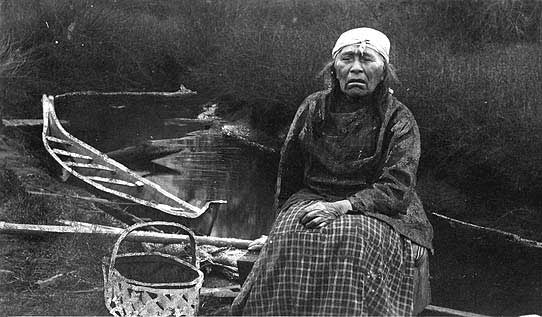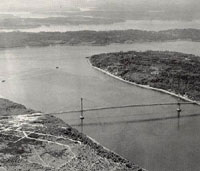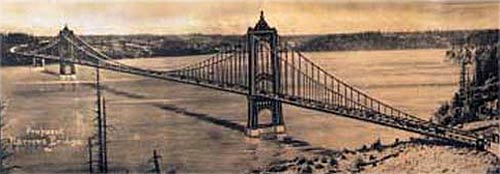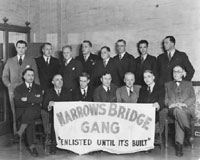Tacoma Narrows Bridge history - Community connections - Crossing the Narrows
Crossing the Narrows: Idea & dream, prehistory to 1937
What's here?
- Prehistory and early history
- The setting
- The idea of bridging the Narrows, 1888-1926
- First crossing - By ferry
- Early efforts for a bridge, 1927-37
- The need - Building a case for a bridge
- The problems - Money and that ferry

Puyallup woman, ca. 1890 UW, NA 1473
Prehistory and early history
In Puget Sound the archaeological record begins about 9,000 years ago. Along the shoreline of the sound, many sites have been identified. Villages were typically located along rivers or marine transportation routes. Artifacts representing daily life include a variety of hunting, fishing and food processing tools, as well as bone and shell implements for fabric and basket weaving.
Fish provided the most valued source of food for Puget Sound peoples. They used all species of salmon. They caught salmon by trolling, by netting from canoes, and by using weirs and nets in rivers and streams. Animals like deer, elk and bear, were nearly as important. Plants, too, offered an abundant source of variety to local diets. Seaweed, grasses, ferns, acorns, roots, and berries provided food, medicines, and materials for making household articles. Native peoples used Western red cedar trees for houses, boxes, baskets, and canoes.
The Tacoma Narrows is part of the traditional territory of Puyallup people. Puyallup villages stretched from Vashon Island and Commencement Bay to Wapato Creek and along the Puyallup River.
The Puyallup's built villages near the Current Tacoma Narrows Bridge. One was called swh'LOH-tseed, located at the head of Wollochet Bay about five miles south of Gig Harbor. Another, called TWAH-well-kawh and located at the mouth of a stream at Gig Harbor, included six buildings in the mid-1800s. On nearby Maury Island stood the village known as tsoo-GWAH-lehlh. It featured a large building, about 50 feet by 200 feet, originally built as a fort to guard against retaliatory measures from the nearby Duwamish people. The Puyallups also lived in three villages near the present-day town of Burton. These were called koh-kohl-chehch, ("madrone"), kwee-LOOT, ("over there"), and AHL-ahl-ehl.
European explorers in May 1792 first came to the region now known as the Tacoma Narrows. On the 20th of May a small group from the British expedition of Captain George Vancouver passed through the Narrows. One of them, a botanist named Archibald Menzies, scribbled his thoughts onto paper, and these became the earliest recorded words about the Narrows. Menzies wrote in his notebook, "a most Rapid Tide from the northward hurried us so fast past the shore that we could scarce land." Soon, Vancouver named the southern part of the great complex waterway after his lieutenant, Peter Puget, who led most of its mapping. Only later did the name get applied to the entire area, which we now call "Puget Sound."
By the mid-1850s, the smallpox and violence associated with Euro-American settlement in the Northwest had drastically affected native people. In 1854 negotiations between Puyallup, Nisqually, and Squaxin Island people and the United States government resulted in the Treaty of Medicine Creek. The agreement forced native peoples to abandon most of their villages in southern Puget Sound and to relocate to reservations. But, the poor quality of reservation lands dissatisfied many of them. The conflict became violent. In 1855 and 1856 the federal sent government Army troops to contain the Puyallups and others. The incidents became known as the Puget Sound Indian Wars. After the wars, first in 1857 then in 1873, the United States government expanded the Puyallup Reservation to 18,032 acres.

The setting
In western Washington state the blue waters of Puget Sound extend southward from the Strait of Juan de Fuca about 90 miles. West of the Sound lies the Olympic Peninsula, some 80 miles wide. The Peninsula is a natural wonderland, topped by great snow-capped mountains (the highest is Mt. Olympus at 10,000 feet). The land is home to wandering deer, elk, bear, and mountain goats.
Before there was a bridge, travelers to the Peninsula faced a long, slow, and expensive journey. The only routes were by highway around the southern end of Puget Sound through Olympia (the state capital), or by ferry from Point Defiance to the west of Tacoma. By the late 1920s, with more and more people driving automobiles, the demand grew for a better route to the Peninsula. At the same time, many citizens came to see the ferry system as "'antiquated" as well as expensive.
The Narrows became a logical site for a bridge. There, near Tacoma, the Sound becomes a narrow channel a little less than a mile wide.
But, it was also a difficult place to build a bridge. The water is over 200 feet deep. Swift, treacherous tides moving at over 8.5 miles per hour (12.5 feet per second) sweep through the channel four times a day. A bridge at the Tacoma Narrows was long proposed, but challenging to build. The sheer cost of construction became a barrier to getting a bridge built.
Tacoma lies in southern Puget Sound where the Puyallup River enters Commencement Bay. The city is surrounded by abundant natural resources, principally timber.
The city evolved through the 1870s and 1880s into a thriving industry town and incorporated in 1884, becoming the seat of Pierce County. After the Northern Pacific Railway reached Tacoma in 1873, the city became a commercial hub for nearby lumbering, coal mining, and flour milling. Across the tide flats east of the city, warehouses and grain elevators sprang up in great numbers. Other enterprises sprouted, including a salmon cannery and machine shops. Since the turn of the 20th century, Tacoma has been a major West Coast port. The one-time "lumber capital of the U. S." remains a center for the regional forest products industry and is one of the leading industrial and commercial cities in the Northwest.
Gig Harbor lies just across the Narrows about 6 miles. The quaint fishing village on a scenic inlet thrives on tourism and boasts a postcard-like view of Mount Rainier.
The idea of bridging the narrows, 1888-1926
First to suggest the notion of bridging the Narrows was John G. Shindler a local rancher. Shindler passed through the Narrows in 1888 (or perhaps 1889) on a steamboat. He pointed to the bluffs on either side and said to boat's commander, "Captain, some day you will see a bridge over these Narrows."
In 1889 the Northern Pacific Railroad briefly contemplated a Narrows Bridge. A clerk in the NP Land Department proposed the link (probably a trestle, rather than a bridge) between Tacoma and Port Orchard, then the site of a proposed Puget Sound Naval Shipyard. But, NP officials had no economic incentive to justify the effort. The idea faded for over thirty years.
The first real promoters of a Narrows Bridge were neighborhood improvement groups on the north side of Tacoma. In 1923 the Federated Improvement Clubs of Tacoma launched a campaign for a Narrows Bridge. They proposed to span the Narrows between Point Defiance and the Gig Harbor area. In late December 1923 C. F. Mason, a realtor and President of the Federated Improvement Clubs told reporters that the group had been working on the project "for some months."
The next step toward a Narrows span came three years later. In 1926 the Tacoma Chamber of Commerce endorsed a campaign for a bridge across the Narrows. Heading the effort was Llewellyn Evans, superintendent of Tacoma City Utilities Department and president of the local Good Roads Association.
First crossing – By ferry
That same year, 1926, Pierce County granted a 10-year contract for ferry service across the Narrows to Mitchell Skansie. The contract guaranteed Skansie that his ferry service would be granted immunity from competition. By the early 1927, Skansie began service with his Washington Navigation Company. That guarantee of "no competition" became a significant impediment to building a bridge. The president of Tacoma's Chamber of Commerce in 1938, Thad Stevenson, put it this way: "Every time we would get started with some financing, that contract would come up and we would have to include its purchase in the total, which was always too high as it was."
Early efforts for a bridge, 1927-37
Between 1927 and 1937 civic groups in Tacoma and surrounding areas made numerous efforts to get a bridge built over the Narrows. These efforts are summarized below.
Proposed Bridges for the Tacoma Narrows: A Chronology
In June 1927 the Roads Committee of the Tacoma Chamber of Commerce estimated that a bridge over the Narrows would cost between $3 million and $10 million. Tacoma newspapers gladly trumpeted their support. Local editors offered publicity, and momentum slowly began to build.
Several proposals for a bridge came forward from local and nationally prominent engineers. Notable were Joseph B. Strauss from Chicago (later builder of the Golden Gate Bridge), H. H. Meyers of New York, and a local civic activist and realtor, Charles A. Cook. In 1928 Cook suggested an $8 million steel cantilever bridge for the Narrows similar to the Carquinez Strait Bridge, then being built near Berkeley, California.

This sketch appeared in Tacoma area newspapers in 1928 as the first proposed bridge type for crossing the Narrows. The image shows the Carquinez Straight Bridge, a steel cantilever structure then under construction in California. WSDOT
In November of 1928 the Tacoma Chamber of Commerce hired noted bridge architect David B. Steinman of the New York firm Robinson and Steinman to conduct preliminary work for the proposed bridge. Over the next two years Steinman spent $5,000 on a preliminary survey, layout and designs, estimates of traffic, architectural drawings, and reports.
Tacoma's 6th Avenue Commercial Club rallied public support. In late December 1928 the Tacoma Chamber of Commerce approved proposed legislation to provide a state franchise for building a bridge at the Narrows. City of Tacoma leaders and Pierce County Board of Commissioners formally requested Washington State officials to construct a Narrows bridge.
By the spring of 1929, the State Legislature passed a law authorizing a Tacoma Narrows Bridge. At the same time, David B. Steinman's design for the bridge appeared in local newspapers.

This 1929 photo by M.D. Boland has a superimposed sketch of the proposed Narrows bridge by David B. Steinman. GHPHSM
Two years passed with little activity. The Tacoma Chamber of Commerce decided that Steinman's firm was "not sufficiently active" and moved on to other ideas.
The next bridge proposal came in 1931 from Tacoma City engineers. They suggested a steel cantilever truss bridge that would carry railroad traffic as well as motor vehicles and pedestrians. The price tag of $12 million shocked almost everyone. The costly idea got more ridicule than support.

1931 Steel cantilever bridge proposed by Tacoma City engineers WSDOT
Hope surged again in November 1932. The Tacoma Chamber of Commerce hired E. M. Chandler of Olympia to build a bridge at the Narrows. Chandler proposed a $3 million suspension bridge. Chandler requested support from the newly created federal Reconstruction Finance Corporation (RFC). The loan would be repaid by tolls collected from bridge users. But, the RFC refused. Too few cars and trucks would use the bridge, they said. And, the cost to buy out Mitchell Skansie's ferry system remained too high. One of the experts hired to review Chandler's proposal was a noted New York engineer, Leon F. Moisseiff.
Chandler announced a new plan a month later. Now, he proposed a 7,000-foot long steel cantilever bridge. But, the idea attracted little support at first. A year passed. Then, in late 1933 the United States Navy and Army Departments declared their support for the proposed Narrows Bridge. The saw a definite military value of the project, because it would link the Bremerton Naval Shipyard and Fort Lewis.
Then, Pierce County government leaders became encouraged by possible support from the new Public Works Agency (PWA). The PWA provided federal funds under President Roosevelt's "New Deal" for public major construction projects, like a bridge over the Tacoma Narrows. Pierce County applied for a grant to build Chandler's steel cantilever bridge at the Narrows. To their disappointment, the federal bureaucracy took no action.
In early 1936 the United States War Department approved a revised application by Pierce County Commissioners for a bridge. The new plan called for a suspension bridge to cost an estimated $4 million. Part (45 percent) of the money was to come from a PWA grant and the remainder (55 percent) to be paid for by Pierce County public utility bonds.
By late March 1936 Tacoma newspapers announced that the New York engineering firm of Moran and Proctor had prepared preliminary plans for a suspension bridge at the Narrows to cost $4,089,091.

In March 1936 the New York engineering firm of Moran and Proctor prepared this preliminary design for a suspension bridge over the Tacoma Narrows WSDOT

Now, the "Narrows Bridge Gang" took up the cause. This coalition of Tacoma community groups and businessmen, launched a statewide letter writing campaign to persuade President Roosevelt to support PWA approval of a Narrows Bridge. The "gang" included members of the Sixth Avenue Business Men's Club, the Gig Harbor Improvement Club, the Young Men's Business Club, the K Street Boosters, and other bridge supporters in the area. The group met weekly from January 1936 until November 30, 1938.
The need – Building a case for a bridge
The automobile exerted a significant influence on American society in the 1920s and increasingly in the early 1930s. Citizens demanded better roads and more bridges. They also wanted fewer ferries and public (not private) ownership of transportation facilities.
Tacoma civic leaders saw the need to reduce driving distances between Tacoma and towns on the Olympic Peninsula as a compelling argument. The table below gives an idea of just how much difference a bridge could make.
| Route | via Olympia | via Narrows Bridge |
|---|---|---|
| Tacoma to Gig Harbor | 107 miles 2 hours 10 minutes |
8 miles 17 minutes |
| Bremerton Naval Shipyard to McChord Air Base | 79 miles 1 hour 50 minutes |
39 miles 55 minutes |
| Tacoma to Port Orchard | 91 miles 2 hours |
21 miles 30 minutes |
| Tacoma to Bremerton | 90 miles 2 hours |
30 miles 40 minutes |
| Tacoma to Port Angeles | 152 miles 3 hours 25 minutes |
115 miles 2 hours 33 minutes |
Peninsula residents felt equally enthusiastic about a Narrows Bridge. From the time of the first white settlement of the area, they wanted a closer connection with their more prosperous neighbors in Tacoma. Business and civic leaders promoted the benefits of better opportunities for trade with the more populated eastern shore of the Sound.
The problems: Money and that ferry
Proponents of a Narrows Bridge justified spending millions of dollars for such a project by explaining that the cost could be repaid by tolls. But, the Peninsula had a small population. Demand for travel to and from the area did not offer a very strong incentive until after the mid-1930s. Even then, federal officials doubted the numbers presented by Tacoma and Peninsula promoters. With the onset of the Great Depression after 1929, the hard times of the 1930s proved an even more difficult hurdle for bridge enthusiasts.
The existing ferry service remained a serious issue that delayed realization of a Narrows Bridge. Federal officials believed that Mitchell Skansie's ferries met local travel and commerce demands. More important, the contract held by Skansie's Washington Navigation Company since 1926 raised an even greater barrier. The exclusive franchise that promised Skansie "no competition" would not expire until 1936. Any bridge deal had to include funds to buy out Skansie.
The end of 1936 brought renewed hope to Tacoma and Peninsula bridge promoters. Skansie's ferry contract ended. Also, increased funding for public works projects under President Franklin D. Roosevelt's "New Deal" held new promise for finding the money to build a Tacoma Narrows Bridge.